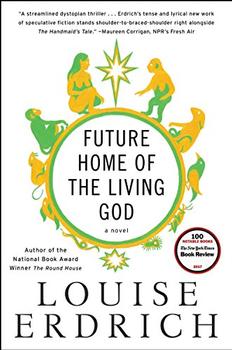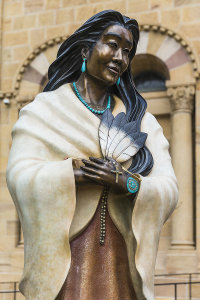Summary | Excerpt | Reviews | Beyond the Book | Read-Alikes | Genres & Themes | Author Bio

Critics' Opinion:
Readers' Opinion:
First Published:
Nov 2017, 288 pages
Paperback:
Nov 2018, 304 pages
 Book Reviewed by:
Book Reviewed by:
Lisa Butts
Buy This Book
This article relates to Future Home of the Living God
In Future Home of the Living God, some of the inhabitants of the reservation that is home to Cedar's birth mother, encounter a vision of Saint Kateri Tekakwitha, causing them to build a shrine in her honor. Tekakwitha was a devoted Catholic who was persecuted for her faith, and Cedar finds meaning in her suffering and inspiration in her perseverance. Tekakwitha is also significant because she is the first canonized Native American saint.
 Tekakwitha was born in present day Auriesville, New York in 1656 to a Christian Algonquin mother and a Mohawk father. The Dutch, French, and English were all battling for territory in the New World at this time, and the Native American villages were frequently visited by Jesuit missionaries. The missionaries were permitted in the Mohawk village due to a trade treaty with France in which furs, weaponry and other metal implements, and alcohol were shipped back and forth from Europe to the New World. Nevertheless, the French and the Native American tribes were regularly at war. Tekakwitha's parents and brother were all killed by a smallpox outbreak when she was four years old. Tekakwitha contracted the illness herself but survived with partial blindness and scarring to her face. The Mohawks blamed the Jesuits for the outbreak (and they may have been right to do so). Tekakwitha was given religious instruction in secret by a missionary named Jacques de Lamberville, converted at age 19, and was subsequently baptized. Facing disapproval of her chosen faith by her remaining family and the other inhabitants of her village, Kateri fled 200 miles to a Catholic mission in the indigenous village of Sault St. Louis in what is Canada today.
Tekakwitha was born in present day Auriesville, New York in 1656 to a Christian Algonquin mother and a Mohawk father. The Dutch, French, and English were all battling for territory in the New World at this time, and the Native American villages were frequently visited by Jesuit missionaries. The missionaries were permitted in the Mohawk village due to a trade treaty with France in which furs, weaponry and other metal implements, and alcohol were shipped back and forth from Europe to the New World. Nevertheless, the French and the Native American tribes were regularly at war. Tekakwitha's parents and brother were all killed by a smallpox outbreak when she was four years old. Tekakwitha contracted the illness herself but survived with partial blindness and scarring to her face. The Mohawks blamed the Jesuits for the outbreak (and they may have been right to do so). Tekakwitha was given religious instruction in secret by a missionary named Jacques de Lamberville, converted at age 19, and was subsequently baptized. Facing disapproval of her chosen faith by her remaining family and the other inhabitants of her village, Kateri fled 200 miles to a Catholic mission in the indigenous village of Sault St. Louis in what is Canada today.
In Sault St. Louis, Tekakwitha was instructed in her new religion by the Iroquois who lived there, and presumably by St. Francis Xavier, who led the mission. She took a vow of chastity and devoted herself entirely to religious study, prayer, and fasting. She also instructed the other residents of the mission and led them in prayer and worship. Many of these people claimed to feel closer to God in her presence. Tekakwitha died in 1680 at age 23 after contracting tuberculosis. Her death was likely precipitated by her extreme fasting and other acts of penance. Her last words were reportedly, "Jesus, I love you." Those present also claimed that her smallpox scars disappeared from her face as she passed away. This was declared a miracle. By 1744, Tekakwitha had come to be known as the "Protectress of Canada." She was beatified by Pope John Paul II in 1980 and canonized by Pope Benedict XVI in 2012. Her tomb is at the St. Francis Xavier Mission at Kahnawake, near Montreal, and there is a shrine devoted to her at her birthplace in Auriesville.
As a patron saint of ecologists and others working to preserve the environment, Kateri Tekakwitha is an appropriate saint to preside over the characters in Future Home of the Living God, as climate change is referenced periodically and seems to be the most likely factor causing the reversal of the evolution process that the novel depicts. When Kateri appears before the people on the reservation, she is angry about the state of the world, and the state of its people's souls.
Picture of Statue Kateri Tekakwitha, from the Cathedral Basilica of St. Francis of Assisi, Santa Fe, NM
Filed under People, Eras & Events
![]() This "beyond the book article" relates to Future Home of the Living God. It originally ran in November 2017 and has been updated for the
November 2018 paperback edition.
Go to magazine.
This "beyond the book article" relates to Future Home of the Living God. It originally ran in November 2017 and has been updated for the
November 2018 paperback edition.
Go to magazine.





The House on Biscayne Bay
by Chanel Cleeton
As death stalks a gothic mansion in Miami, the lives of two women intertwine as the past and present collide.

The Flower Sisters
by Michelle Collins Anderson
From the new Fannie Flagg of the Ozarks, a richly-woven story of family, forgiveness, and reinvention.

The Funeral Cryer by Wenyan Lu
Debut novelist Wenyan Lu brings us this witty yet profound story about one woman's midlife reawakening in contemporary rural China.
Your guide toexceptional books
BookBrowse seeks out and recommends the best in contemporary fiction and nonfiction—books that not only engage and entertain but also deepen our understanding of ourselves and the world around us.